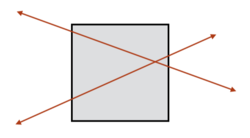Random Lines Through Square
 A line is drawn passing through a random point along each of the two vertical sides of the square above. If two such lines are drawn, what is the probability that they intersect within the square?
A line is drawn passing through a random point along each of the two vertical sides of the square above. If two such lines are drawn, what is the probability that they intersect within the square?
The answer is 0.5.
This section requires Javascript.
You are seeing this because something didn't load right. We suggest you, (a) try
refreshing the page, (b) enabling javascript if it is disabled on your browser and,
finally, (c)
loading the
non-javascript version of this page
. We're sorry about the hassle.
If the two lines share precisely one endpoint then they cannot intersect strictly within the square. If they share both endpoints then they are the same line and thus intersect within the square (at an infinite number of points). However, as these are (technically) a zero-probability events, we can assume that each line has a distinct endpoint on each vertical side of the square without affecting our probability calculation.
Now choose two (distinct) points, uniformly and at random, on each vertical side of the square. Let U 1 , U 2 be the uppermost points chosen on the left and right sides, respectively, and L 1 , L 2 be the respective lowermost points. With equal probability we can then draw a line from U 1 to either U 2 or L 2 , leaving U 2 to be connected by a line to L 2 or U 2 , respectively. If U 1 is connected to L 2 then the two lines will cross, and if U 1 is connected to U 2 then the lines will not cross. Thus there is a probability of 0 . 5 that two lines, drawn randomly as described, will intersect strictly within the square.